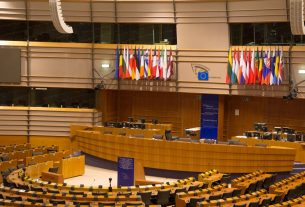[ad_1]
Dr Carmen García Sánchez likes to ride her bike in the Danish countryside. That is how she first discovered how closely post-war Danish architecture is linked to nature.
A practising architect, she was inspired to dive into the study of biophilic architecture, which allows people to enjoy the everyday benefits of being closer to nature from the comfort of their own homes.
“Biophilia means love of life. It relates to our innate need to be in contact with nature. There’s a restoring effect that comes from being connected to the natural world,” said García Sánchez, who was also a postdoctoral researcher at the Royal Danish Academy – Architecture, Design, Conservation, in Copenhagen and is currently an assistant professor at the Universidad Rey Juan Carlos in Madrid.
Inside-outside
Thanks to funding from the EU, she has been able to build a bridge between architectural practice and academic research through her Nature-In project, which ran from 2020 to 2024.
“Architects have always been interested in improving people’s lives, but this connection to nature is underexplored. I felt I could bring something innovative to my practice and also that of other European architects,” she said.
García Sánchez hopes that her research could inform governments and architects alike on how to better integrate nature into the design of indoor spaces, particularly in urban environments.
“
Architects have always been interested in improving people’s lives, but this connection to nature is underexplored.
A visit to Japan brought another revelation. Travelling across the country, García Sánchez came to appreciate how the Japanese have lived and built their houses for centuries with an “inside-outside” vision, designing functional buildings that allow their inhabitants to experience nature from the inside.
“There’s an ancestral need to connect to nature,” said García Sánchez, who explains that the more people are trained to enjoy nature, the more benefits they get.
She explains that biophilic design is not only about placing plants everywhere. It is about being aware of nature in all its manifestations, such as daylight, water, materials, the passing of time and the forces of nature.
Nature-based design
Now a recognised expert in the field, García Sánchez has been invited to share her knowledge at this year’s World Expo being held in Osaka, Japan, from 13 April to 13 October 2025.
Nature-based design features prominently at Expo 2025, which has been organised around the theme ‘Designing future society for our lives’.
“
There’s a restoring effect that comes from being connected to the natural world.
The EU’s ‘Nurturing Tomorrow’ pavilion was designed to embody the principles of the New European Bauhaus – an initiative that seeks to transform our living spaces by merging sustainability, aesthetics and inclusivity. Those principles also align nicely with Nature-In’s vision.
Along with Japanese architect and researcher Dr Ryo Murata, an associate professor in the Department of Architecture and Building Engineering at the Institute of Science Tokyo, García Sánchez will introduce visitors to the traditional connection with nature in Japanese and Danish architecture.
Together, they will explore how to make cities and buildings more liveable through closer contact with nature and discuss how people can improve their health and well-being by designing their homes with nature in mind.
Natural connection
These are not trivial questions. It is estimated that most people spend 80% to 90% of their time indoors. In densely populated cities, people have lost contact with the healing power of nature.
Transforming our indoor environments could increase our well-being and also strengthen our relationship with nature and, therefore, our willingness to preserve it. The closer we are to the natural world, the more we can appreciate it and want to protect it.
For García Sánchez, it is important that the brain can perceive nature’s natural rhythms: light and dark, for example, through exposure to natural light.
She points out that we experience nature through all our senses, so small details matter. This might be leaves outside casting shadows in a flat, the feel of wooden floors under bare feet, or even the smell of stones in a courtyard after the rain.
“Nature is constantly telling us: ‘I’m here. You forgot it, but I’m in the cities too. I’m everywhere,’” she said. With climate change and extreme events such as floods, fires and earthquakes becoming more frequent, she believes that the need to reconnect with the natural world is becoming more urgent.
“Even the most extreme phenomena, such as earthquakes, are Mother Nature’s way of reminding us that she’s there.”
The old anthropocentric approach that sees nature as something humans have to harness for their own benefit has become obsolete. To make a difference, we have to bring nature back into our lives. We need to live in it and with it.
Research in this article was funded by the EU’s Horizon Programme. The views of the interviewees don’t necessarily reflect those of the European Commission. If you liked this article, please consider sharing it on social media.
Showcasing EU research at the World Expo
Osaka, Japan
13 April – 13 October
This summer, millions of people from around the world will head to Osaka, Japan, for Expo 2025. At this global gathering, countries and regions will share how they’re tackling some of today’s biggest challenges, from sustainability and digital connectivity to inclusivity and security.
The central theme of this year’s event is Designing Future Society for Our Lives. Visitors will get a chance to see how EU-funded research is helping shape that future. The EU’s Nurturing Tomorrow pavilion reflects Europe’s commitment to building a greener, more connected and inclusive world.
The EU pavilion is hosting exhibitions, talks and interactive experiences that spotlight cutting-edge EU research and innovation projects – all aimed at solving real-world problems and building international cooperation. Whether you’re curious about the future of clean energy, digital tech, or inclusive design, there’s something for everyone.
The Nature-In project will be presented on 20 June, during the Health and Wellbeing week (from 20 June to 1 July). Visitors will be able to attend presentations and discussions with Dr Carmen Garcia Sánchez and Dr Ryo Murata on the health benefits of connecting with nature, followed by guided walks to designated pavilions.
Virtual visit
Can’t go to Osaka? Explore the Expo online at: https://www.expo2025.or.jp/en/future-index/virtual/virtual-site/
[ad_2]
Source link



